
Headless CMS scales and improves WPWhiteBoard’s content distribution, flexibility, and personalization
Aniket Ashtikar
Is your e-commerce site feeling more like an anchor and less like a growth driver, dragging you behind as the market accelerates? If you're a tech leader, you've most probably come across these buzzwords like "Composable Commerce", "MACH", and "Headless", abound, promising agility and innovation.
But the discussion around them is usually so thick and technical that it only causes more confusion than clarity, having you stuck and not knowing the way to go with your business. You know that you need to change, but the "how" is a frustrating question.
Let's cut through the fog right now.
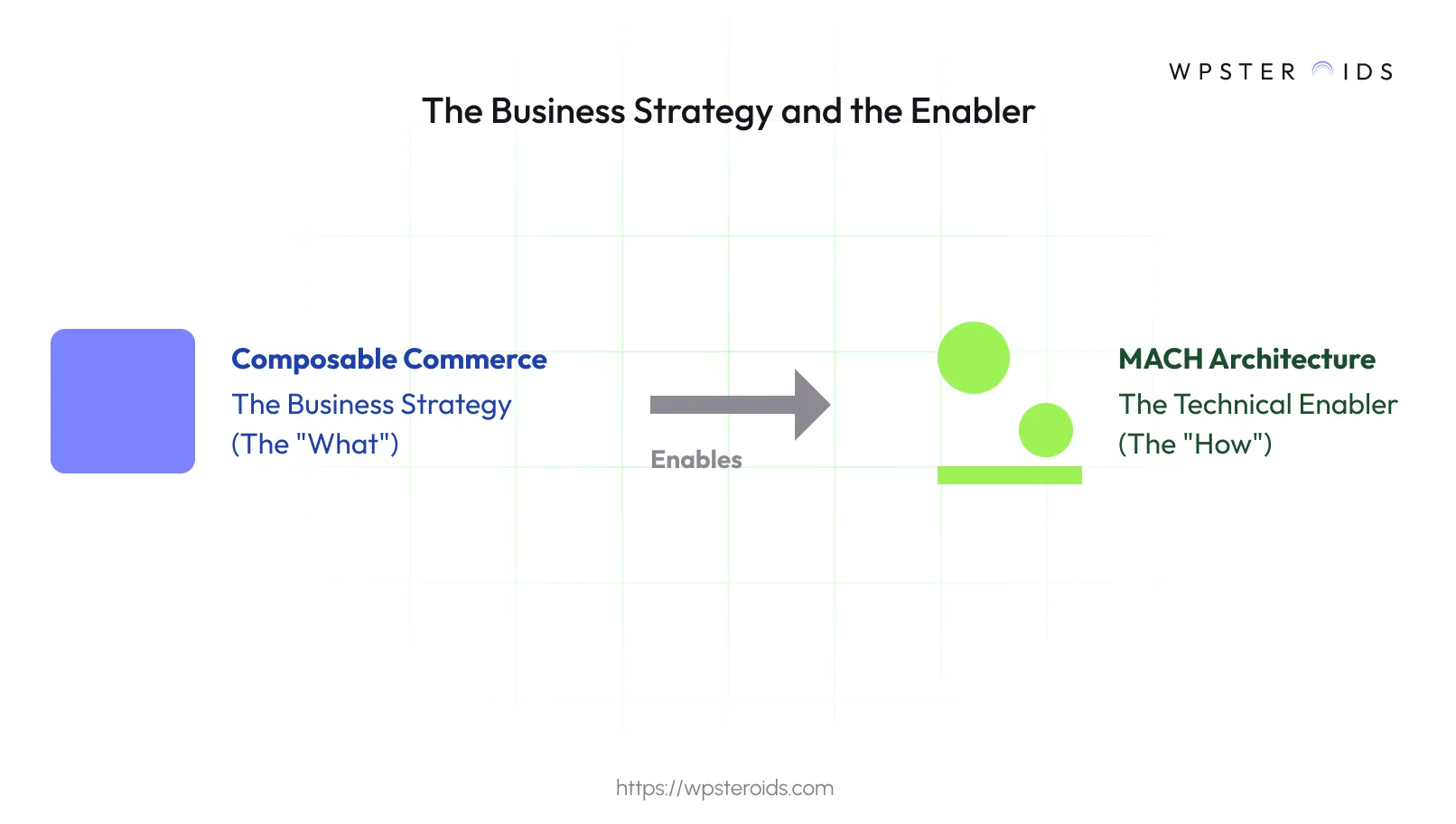
The fundamental distinction is that MACH Architecture is the technical specification (the "how"), whereas Composable Commerce is the business plan utilizing this specification to build a best-of-breed solution (the "what").
For years, the all-in-one, monolithic commerce platform was the gold standard. It offered a single, unified solution for everything from the product catalog and shopping cart to the customer-facing website.
It was predictable, stable, and for a time, it worked. But the digital world has changed, and the demands placed on your business have changed with it.
If you're managing a traditional platform, you know the feeling. The marketing team wants to launch a new, personalized campaign, but it requires a six-month development cycle. A small bug fix in one area risks bringing down the entire system.
Integrating a new payment provider or a loyalty program becomes a monumental, custom-coded project. This is the reality of monolithic commerce.
These platforms were built for a different era. They are inherently rigid, coupling the front-end user experience (the "head") tightly to the back-end logic and database. Every component is intertwined, creating a single, massive block of code.
As a result, you can't adapt or innovate quickly. Your platform, which should be your greatest asset, becomes your biggest bottleneck, preventing your business from responding to market shifts or customer expectations.
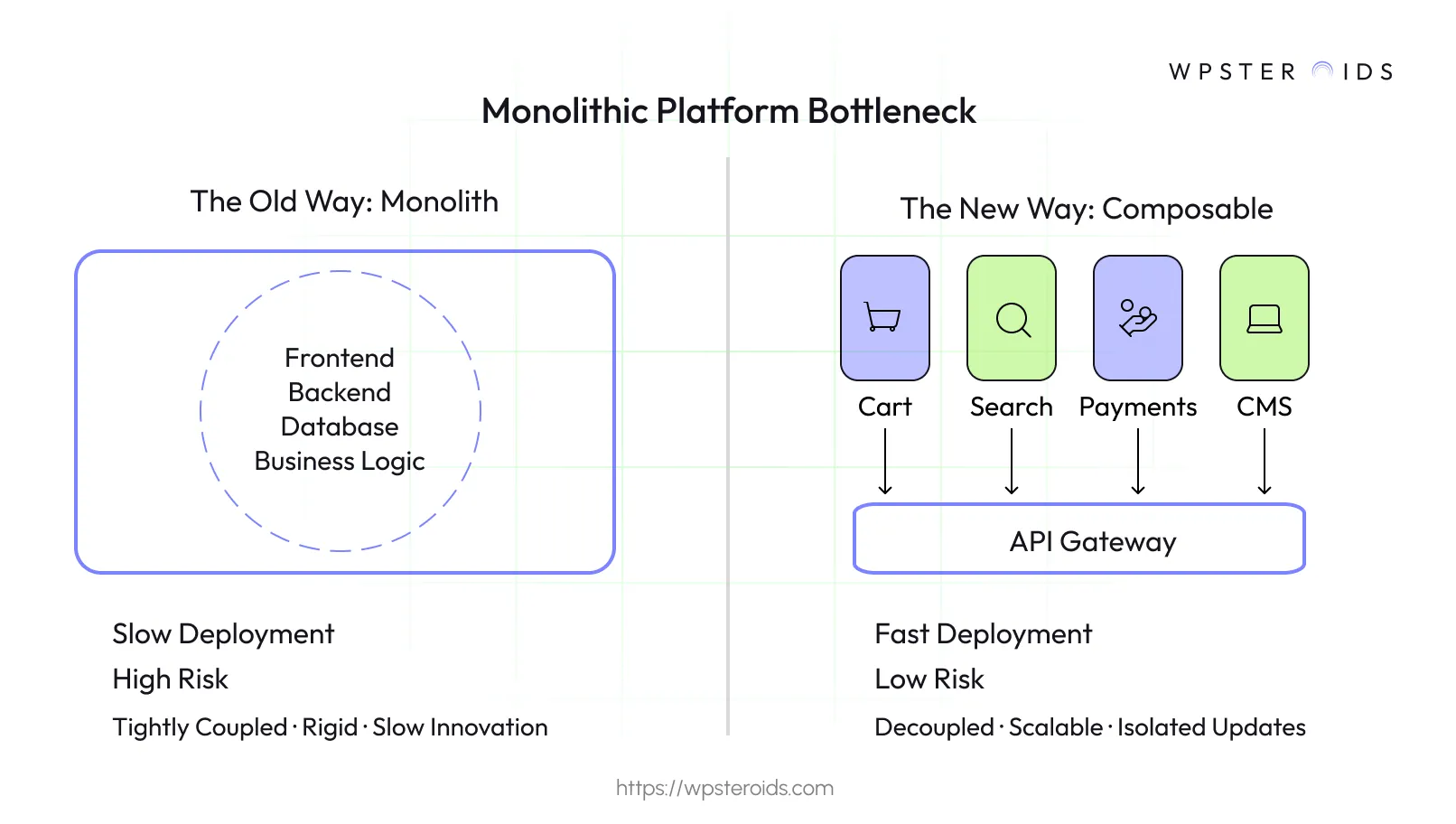
The instinct is to see this as purely a technology problem—if we just replace the old tech with new tech, we'll be agile. But that's a trap. The biggest hurdle in moving to a more flexible architecture is rarely technical; it's cultural.
True success requires a fundamental shift in how your teams are structured and empowered. Many organizations attempt to adopt agile technologies like microservices while keeping their old, rigid, "monolithic" organizational chart.
They keep development, marketing, and operations in separate silos, creating the same bottlenecks and communication gaps the new technology was meant to solve.
To truly capitalize on modern architecture, you must move from siloed, project-based teams to empowered, cross-functional "product teams".
This model allows businesses to decouple their organization to mirror the decoupled technology. Without this organizational redesign, the technology alone will fail to deliver on its promise.
To adapt and innovate effectively, you need to change how you work, not just what you work with.
To truly grasp how these pieces fit together, it's essential to understand what each term means on its own. They aren't just jargon; they represent distinct layers of a modern digital stack, each building upon the last.
The first step away from the monolith is going "headless." A headless commerce architecture simply means separating the front-end presentation layer (the "head") from the back-end commerce engine (the "body").
Think of it like this: your back-end becomes a library of commerce functions that can be called upon by any front-end you want to build. This is achieved through APIs.
This decoupling immediately gives you more freedom. You're no longer locked into the pre-built templates of a traditional platform.
Your front-end developers can use the modern frameworks they prefer to build unique and lightning-fast user experiences, while your back-end team focuses purely on the core commerce functionality.
This backend headless architecture is the foundational concept for greater flexibility.
If headless is the first step, MACH architecture is the comprehensive technical standard that ensures your entire system is built for the future. It’s an acronym representing a set of four interconnected principles.
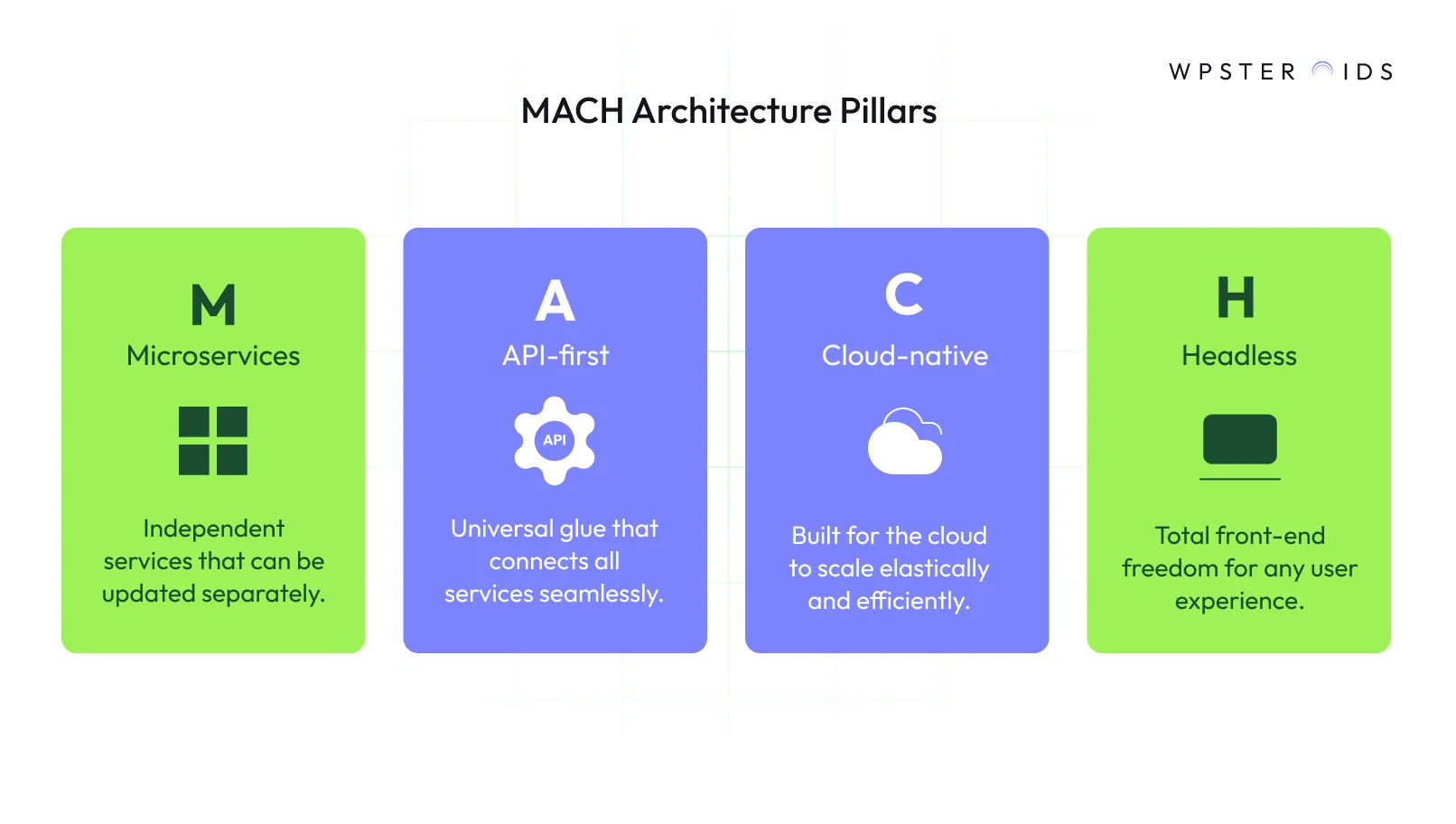
MACH is the technical blueprint for agility. It’s a set of rules that guarantees any system built this way will be flexible, scalable, and interchangeable.
This brings us to Composable Commerce. If MACH is the technical blueprint, Composable Commerce is the business strategy you execute using that blueprint.
It’s the philosophy of selecting best-in-class solutions from different vendors for each piece of your business and "composing" them into a single, custom solution that perfectly fits your needs.
To make this crystal clear, let's use an analogy. Think of building your company’s e-commerce presence like building a custom home.
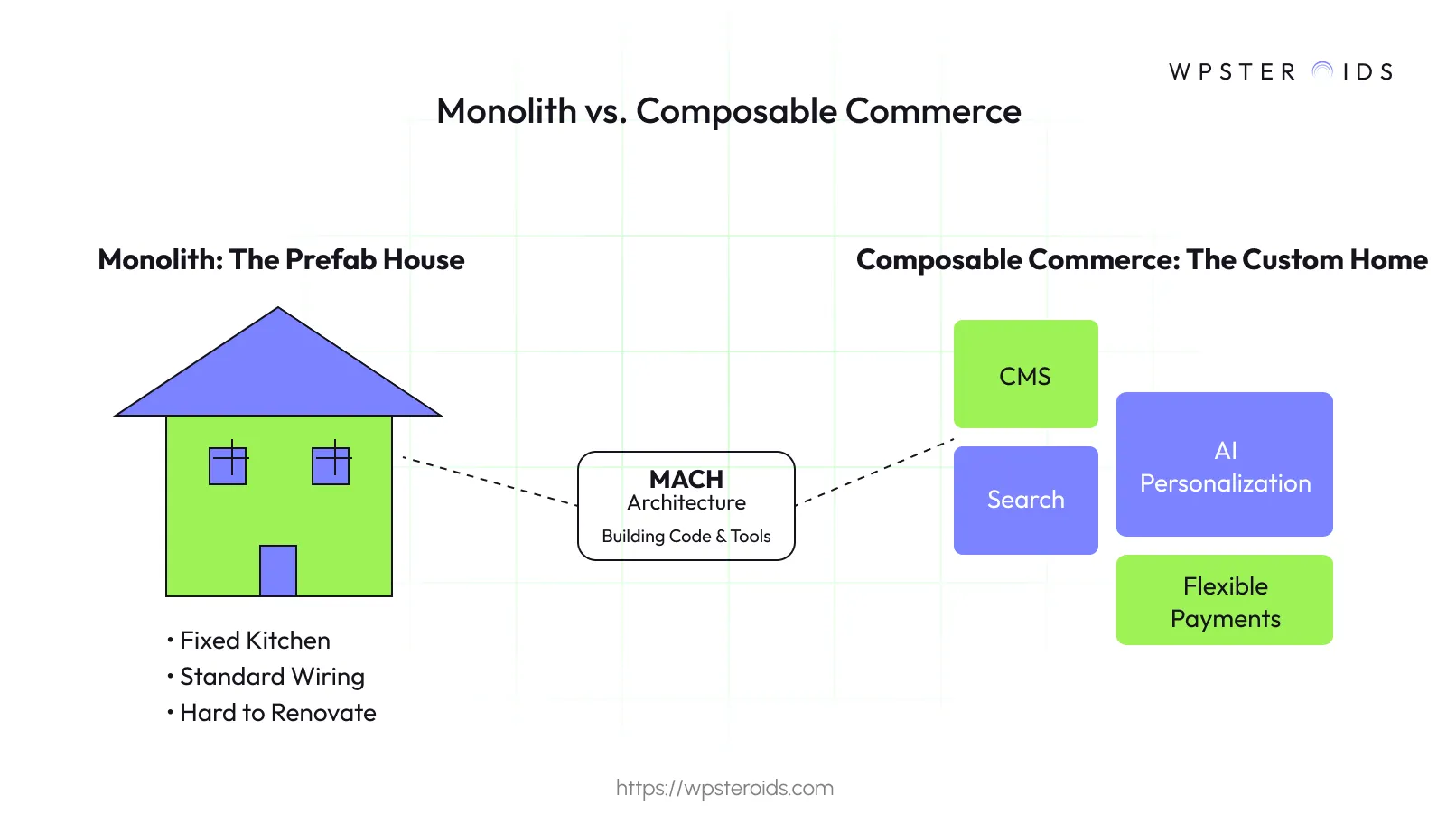
This is the essence of Composable Commerce: strategically building your ideal business solution by selecting and combining the best tools for the job, all held together by the reliable, flexible principles of MACH architecture.
So, let's address the central question head-on: What is the real difference between MACH vs. Composable? The most critical takeaway is that this is not an "either/or" choice. The core difference lies in their function—one is a technical foundation, and the other is a business methodology that builds upon it.
Comparing them directly is like asking about the difference between a high-tech workshop and the custom car you build inside it. They aren't in competition; one makes the other possible.
Think of MACH as the non-negotiable set of engineering principles for any modern commerce component. It’s a strict quality standard.
When a service—whether it’s a search engine, a payment gateway, or a CMS—is "MACH-certified," it guarantees that it was built to be:
MACH is the technical blueprint. It doesn't tell you *what* to build. It simply provides the rules and foundation to ensure that whatever you choose to build will be flexible, resilient, and future-proof.
Composable Commerce, on the other hand, is the strategic approach of your business leaders. It's the active process of scanning the marketplace, identifying the absolute best-in-class solutions for each business need, and assembling them into a cohesive whole.
This is where you make the key business decisions. You might decide that Vendor A has the most intelligent search functionality, Vendor B offers the most flexible promotions engine, and Vendor C provides the most user-friendly content management system.
This approach centers around the idea of "Packaged Business Capabilities" (PBCs). A PBC is a software component that represents a specific business function, like "shopping cart" or "customer reviews".
A composable headless strategy is the art of selecting these best-of-breed PBCs—all of which should adhere to MACH principles—and combining them to create your perfect commerce solution.
It’s impossible to execute a true Composable Commerce strategy without the foundation of MACH architecture. The business goal of "composing" your ideal tech stack relies entirely on the technical capabilities that MACH principles provide. They are the gears and levers that make the whole system work.
Let's break down exactly how each pillar of MACH serves as a prerequisite for a successful composable strategy:
The very idea of Composable Commerce is to assemble your solution from different components. Microservices provide those components.
By breaking down massive applications into small, independent services (like a cart, search, or payment service), the architecture allows businesses to treat each function as a swappable building block.
Don't like your current search provider? You can unplug that microservice and plug in a new one without having to tear down the entire structure. This modularity is the essence of "composing".
Having a box full of best-of-breed components is useless if they can't communicate. This is where the API-first principle is critical. APIs act as the standardized contract or universal adapter between all your different microservices.
They ensure that your new promotions engine from Vendor A can seamlessly pass information to your checkout service from Vendor B.
This eliminates the need for brittle, costly custom integrations for every new `add-on`, creating a stable and reliable ecosystem where all parts speak the same language.
A composable solution, made up of many different services, needs an infrastructure that is both resilient and elastic. Cloud-native architecture provides this.
When a flash sale hits, you can instantly scale up only the necessary services—like inventory and checkout—without paying to scale the entire application.
This provides a level of efficiency and resilience that a monolith can't match.
Finally, the headless principle ensures that your strategic backend choices don't restrict your customer-facing creativity. By decoupling the front-end "head" from the back-end commerce engine, you are free to build any user experience you can dream of.
You can feed your composed commerce engine into a beautiful website, a native mobile app, an in-store kiosk, or a voice assistant, all at the same time. This front-end freedom ensures that your ability to connect with your customers is never limited by the technology that runs in the background.
Essentially, every pillar of MACH directly enables the promise of Composable Commerce. You cannot have a truly composable system that isn't modular (Microservices), interconnected (API-first), scalable (Cloud-native), and flexible at the presentation layer (Headless). MACH is the technical engine that brings the composable business strategy to life.

Adopting a Composable Commerce strategy powered by MACH architecture is more than just a technical upgrade; it's a fundamental business transformation.
This partnership directly addresses the most significant limitations of monolithic systems, unlocking tangible growth by changing how you scale, innovate, and compete.
With a traditional platform, you are locked into a single vendor's ecosystem—their features, their roadmap, and their limitations. Innovation happens at their pace, not yours.
A composable approach shatters this dependency. You gain the freedom to select best-of-breed solutions for every business need, allowing you to adapt and personalize customer experiences with a precision that monoliths can't offer.
This model not only future-proofs your business against technological stagnation but also drastically improves how you scale. Instead of scaling your entire, massive application during peak traffic, the cloud-native nature of MACH allows you to scale only the specific microservices that are under load, saving immense cost and improving performance.
Furthermore, 79% saw similar improvements in their ability to meet business requirements. For a leader struggling to keep up with marketing demands and customer expectations, these numbers represent a clear pathway from frustration to tangible business impact.
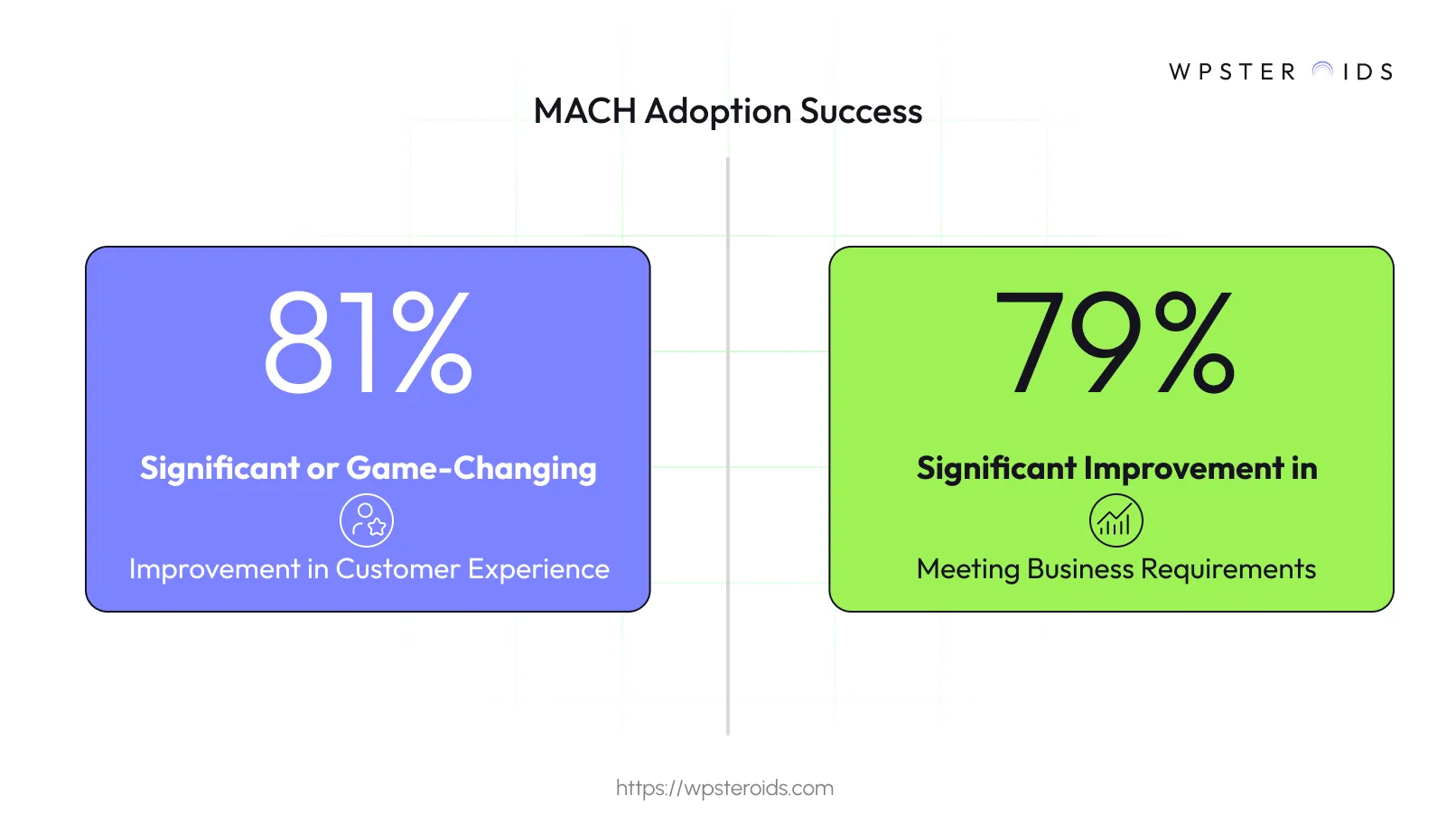
Perhaps the most immediate and profound impact of this partnership is the dramatic increase in development speed. In a monolithic world, launching a new feature is a high-stakes, time-consuming ordeal.
A single, interconnected codebase means any change requires extensive testing to ensure it doesn't break something else, and deployment cycles can stretch for months.
The microservices-based, composable model fundamentally changes this dynamic. Small, independent teams can work in parallel on their specific services.
The team managing the promotions engine can develop, test, and deploy a new feature without waiting for the search team or the checkout team. The risk is isolated, the process is streamlined, and the cycle is drastically shortened.
This accelerated development of new features means your business can finally operate at the speed of the market. You can launch campaigns, test hypotheses, and respond to consumer trends in weeks or even days, not quarters.
This agility is the ultimate competitive advantage, allowing you to outmaneuver slower rivals and continuously deliver value to your customers.
This is a natural question, but based on everything we've covered, you can probably guess the answer: you don't. The question itself is a holdover from the old way of thinking, where you had to choose one vendor's all-in-one suite over another's.
In this new paradigm, it's not about choosing between Composable Commerce and MACH architecture. The more effective question for a leader like you to ask is: "Which concept should my teams focus on, and at what stage?"
The answer clarifies the roles within your organization and the stages of your transformation journey.
Your technical leadership—your CTO, solution architects, and senior engineers—should have their focus squarely on MACH principles. This is their domain.
When they are evaluating any new potential vendor or software component, whether it’s for content management, search, or payments, their first question should be: "Is it built according to MACH standards?"
The MACH principles are the technical team's non-negotiable standard. They ensure that any tool allowed into your ecosystem is a high-quality, interchangeable part, not a Trojan horse that secretly creates a new monolith.
Your business leadership—your CEO, Chief Product Officer, Head of E-commerce, and marketing leaders—should focus on the vision of Composable Commerce. This is their strategic framework.
They shouldn't get bogged down in the technical details of APIs or cloud-native hosting. Instead, their energy should be spent identifying the unique business capabilities needed to win in your market.
The business team's job is to dream up the perfect "custom home" by identifying the best-in-class features that will serve your customers.
Imagine your Head of Marketing wants a more powerful promotions engine.
You don't choose one or the other. You use MACH principles as the technical gatekeeper to enable your broader Composable Commerce business strategy.
The promise of a flexible, future-proof commerce platform is incredibly compelling. However, the journey to a truly composable architecture is a significant strategic undertaking, not a simple technical swap.
To succeed, you need to anticipate and plan for a new set of challenges that extend far beyond the code itself.
As we touched on earlier, the single greatest point of failure in a move to composability has little to do with technology. It's organizational. You cannot bolt a flexible, agile architecture onto a rigid, siloed organization and expect it to work.
If your teams are still structured in traditional buckets—with hard walls between development, marketing, and operations—you will simply recreate the same bottlenecks you had with your monolith.
Successfully embracing this model requires you to adapt and innovate your internal structures. It demands a deliberate shift towards empowered, cross-functional product teams that own their business capability end-to-end.
This is a cultural change that requires executive buy-in, investment in new skills, and a willingness to rethink how work gets done in your company.
When you buy a monolith, you have one throat to choke. When something goes wrong, you know exactly who to call. In a composable world, you are the master orchestrator of a multi-vendor ecosystem.
This is incredibly empowering, but it introduces a new layer of complexity: governance.
Your role shifts from being a customer of a single solution business to becoming the general manager of your own unique platform. This requires a strong governance framework to answer critical questions:
Developing a clear strategy for vendor management and technical orchestration is no longer an afterthought; it's a core competency required for a composable model to thrive.
It’s tempting to compare the license fee of a single monolith to the sum of the fees for several smaller microservices and assume a cost saving. The reality is more complex. Evaluating the Total Cost of Ownership (TCO) is essential for presenting a realistic business case.
While individual component costs may be lower, you must also factor in:
However, the cost equation isn't just about expenses. The true financial benefit comes from the agility you unlock. What is the cost of a six-month delay in launching a critical new feature?
What is the revenue lost when your rigid platform can't support a new sales channel? The TCO of a composable stack is an investment in speed, flexibility, and the long-term health of your business.
Let's bring it all home. The fog of war created by industry buzzwords can be thick, but the relationship between these concepts is, at its heart, simple and powerful.
To recap, MACH architecture is the "how"—the technical foundation that guarantees flexibility and scalability.
Composable Commerce is the "what"—the strategic approach you build upon that foundation, selecting the best tools for your specific business needs.
The entire goal of this evolution is to move away from a rigid, prefabricated system that dictates your strategy, and toward a flexible, custom-built solution that perfectly fits and accelerates it.
If you remember only one thing from this guide, let it be this: The modern approach to commerce isn't about choosing between competing technologies; it's about adopting a strategic mindset (Composable) that is finally made possible by a flexible architecture (MACH).
You are no longer just buying a product; you are architecting a solution business that can adapt and win in a constantly changing market.
You've seen the limitations of your monolith firsthand. You now understand the strategic partnership that can set you free. The path forward is clearer. The only remaining question is when to start.
Ready to escape your monolith and build an agile, future-proof commerce experience? Book your discovery call with our experts today to map out your unique path to composable success.
